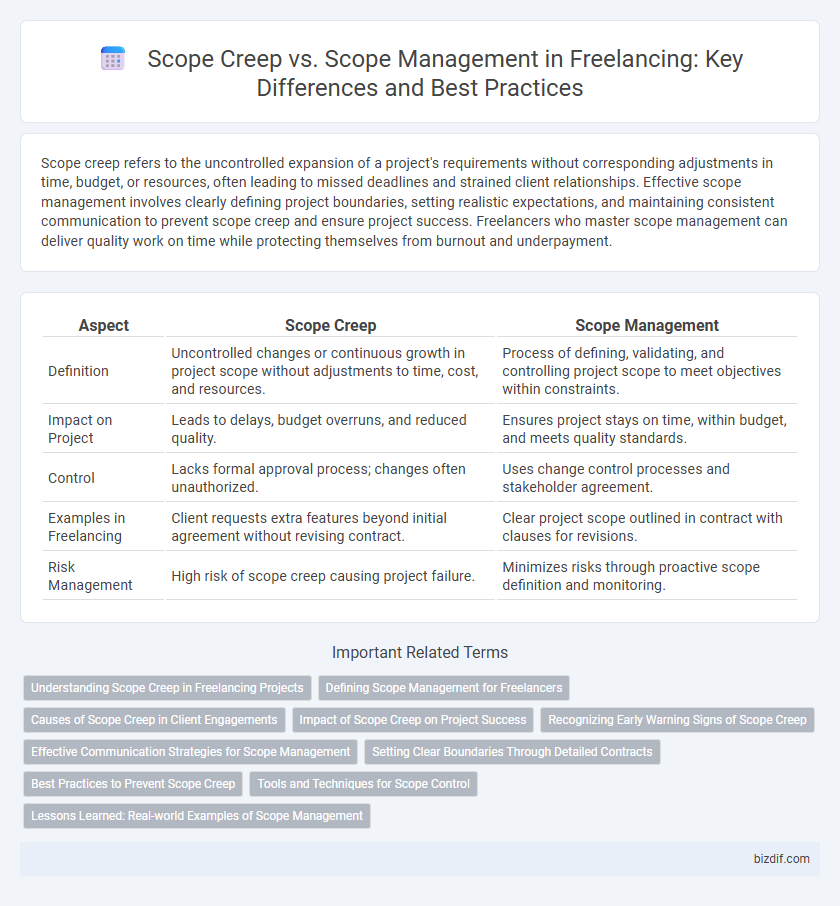Scope creep refers to the uncontrolled expansion of a project's requirements without corresponding adjustments in time, budget, or resources, often leading to missed deadlines and strained client relationships. Effective scope management involves clearly defining project boundaries, setting realistic expectations, and maintaining consistent communication to prevent scope creep and ensure project success. Freelancers who master scope management can deliver quality work on time while protecting themselves from burnout and underpayment.
Table of Comparison
| Aspect | Scope Creep | Scope Management |
|---|---|---|
| Definition | Uncontrolled changes or continuous growth in project scope without adjustments to time, cost, and resources. | Process of defining, validating, and controlling project scope to meet objectives within constraints. |
| Impact on Project | Leads to delays, budget overruns, and reduced quality. | Ensures project stays on time, within budget, and meets quality standards. |
| Control | Lacks formal approval process; changes often unauthorized. | Uses change control processes and stakeholder agreement. |
| Examples in Freelancing | Client requests extra features beyond initial agreement without revising contract. | Clear project scope outlined in contract with clauses for revisions. |
| Risk Management | High risk of scope creep causing project failure. | Minimizes risks through proactive scope definition and monitoring. |
Understanding Scope Creep in Freelancing Projects
Scope creep in freelancing projects refers to uncontrolled changes or continuous growth in a project's scope without corresponding adjustments in time, budget, or resources. Mismanaged scope creep leads to missed deadlines, budget overruns, and strained client relationships, emphasizing the importance of clear project boundaries and thorough scope management. Effective scope management involves defining detailed project deliverables, setting clear expectations, and implementing change control processes to maintain project focus and client satisfaction.
Defining Scope Management for Freelancers
Scope management for freelancers involves clearly defining project boundaries, deliverables, and timelines to prevent scope creep--the uncontrolled expansion of work beyond the initial agreement. Establishing detailed contracts and maintaining open communication with clients ensures that all requirements are documented and agreed upon, reducing the risk of unexpected tasks affecting project costs and deadlines. Effective scope management empowers freelancers to manage workloads efficiently, deliver projects on time, and maintain client satisfaction by setting realistic expectations.
Causes of Scope Creep in Client Engagements
Scope creep in client engagements often arises from unclear project requirements, frequent client requests for additional features, and inadequate communication between freelancers and clients. Misaligned expectations and lack of formalized change control processes exacerbate scope creep, leading to project delays and budget overruns. Effective scope management involves setting clear boundaries, documenting agreements, and maintaining continuous dialogue to prevent these common causes.
Impact of Scope Creep on Project Success
Scope creep significantly jeopardizes project success by introducing unplanned tasks and expanding deliverables beyond the original agreement, leading to missed deadlines and budget overruns. Freelancers experience increased stress and compromised quality as uncontrolled changes strain resources and disrupt workflow. Effective scope management mitigates these risks by establishing clear boundaries, aligning client expectations, and maintaining project focus.
Recognizing Early Warning Signs of Scope Creep
Recognizing early warning signs of scope creep in freelancing is essential for effective scope management and project success. Frequent client requests for additional features beyond the initial agreement, ambiguous project goals, and a lack of clear deliverables signal potential scope creep. Proactively setting boundaries, documenting changes, and maintaining transparent communication prevent project delays and budget overruns.
Effective Communication Strategies for Scope Management
Effective communication strategies in scope management prevent scope creep by ensuring clear, concise documentation of project requirements and regular stakeholder updates. Establishing defined channels for feedback and change requests helps maintain alignment on project objectives, reducing misunderstandings and unauthorized work expansions. Transparent dialogue between freelancers and clients fosters trust and enables proactive adjustments, keeping projects within agreed scopes and deadlines.
Setting Clear Boundaries Through Detailed Contracts
Effective scope management in freelancing hinges on setting clear boundaries through detailed contracts that explicitly define deliverables, timelines, and payment terms. Precise documentation minimizes the risk of scope creep by ensuring all parties have a shared understanding of project expectations and limitations. Well-structured contracts serve as a critical tool for freelancers to safeguard against unauthorized changes and maintain control over workload and resources.
Best Practices to Prevent Scope Creep
Effective scope management in freelancing requires clearly defining project deliverables and setting realistic boundaries from the outset. Regular communication with clients, documented change requests, and using project management tools help track progress and prevent scope creep. Establishing a detailed contract with scope limitations and approval procedures ensures project goals remain aligned and protects both freelancer and client interests.
Tools and Techniques for Scope Control
Effective scope control in freelancing relies on robust tools like project management software (e.g., Trello, Asana) and techniques such as Work Breakdown Structure (WBS) to define clear deliverables. Time tracking tools combined with regular client communication help identify and prevent scope creep by ensuring continuous alignment on project expectations. Implementing change request processes and version control systems also supports disciplined scope management, minimizing disruptions and maintaining project focus.
Lessons Learned: Real-world Examples of Scope Management
Effective scope management prevents scope creep, where unplanned tasks expand project boundaries and derail timelines. Lessons from real-world freelancing projects highlight the importance of clear contract terms and regular client communication to manage expectations and deliverables. Tracking changes through detailed documentation ensures control over project scope and enhances client satisfaction.
Scope Creep vs Scope Management Infographic

 bizdif.com
bizdif.com